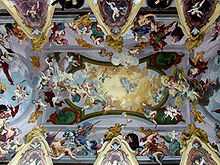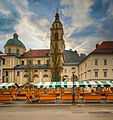Ljubljana Cathedral
| St Nicholas Cathedral | |
|---|---|
|
Native name Slovene: Ljubljanska stolnica | |
|
The Cathedral seen from the Ljubljana Central Market | |
| Location |
Ljubljana, |
| Coordinates | 46°03′02″N 14°30′28″E / 46.05056°N 14.50778°ECoordinates: 46°03′02″N 14°30′28″E / 46.05056°N 14.50778°E |
| Governing body | Roman Catholic Church |
_location_map.svg.png) Location of St Nicholas Cathedral in Slovenia | |
Ljubljana Cathedral (Slovene: Ljubljanska stolnica), also named Saint Nicholas' Church (cerkev svetega Nikolaja, šenklavška cerkev), Saint Nicholas' Cathedral (Slovene: Stolnica svetega Nikolaja), the Cathedral of Saint Nicholas, or simply the Cathedral (Stolnica), is a cathedral in Ljubljana, the capital of Slovenia.[1] Originally, Ljubljana Cathedral was a Gothic church. In the early 18th century, it was replaced by a Baroque building. It is an easily recognizable landmark of the city with its green dome and twin towers and is located on Cyril and Methodius Square by the nearby Ljubljana Central Market and the Town Hall.[2]
History
Predecessor churches

The site was originally occupied by an aisled three-nave Romanesque church, the oldest mention of which dates from 1262. An extensive fire in 1361 saw it refurbished in the Gothic style but underwent alterations when the Diocese of Ljubljana was established in 1461 and the church became a cathedral. However, in 1469 it was burnt down again. This time, it was suspected to be arson, presumably by the Turks.[3]
Baroque cathedral
In 1700, at the initiative of Dean Johann Gregor Thalnitscher and the Academia Operosorum Labacensium, the Capuchin friar Florentianus Ponnensis from Milan or Bologna designed a new Baroque hall church.[4] The following year, after the construction already started, the plan was revised and complemented by the Jesuit architect Andrea Pozzo who designed it as a basilica and added to it a dome. He did not supervise the realisation of his plan, so the buildings was also adapted by the builders.[5] The two belfries, resembling of the Salzburg Cathedral, were added upon the plan by Lombard Giulio Quaglio.[6]
The construction took place between 1701 and 1706. It was led by Francesco Bombasi, who already after a few months replaced the unreliable Francesco Feratta, and Mihael Zamerl.[7] The master builder was Pavel Jugovic, and after his death in March 1704, Gregor Maček.[7] The construction was completed in 1706, the first worship took place in the new building in August 1706, and the consecration took place on 8 May 1707.[6] Originally, a fake dome was painted on the arch above the centre until the church's real dome was constructed by Matej Medved in 1841.[7]
Description
The church is recognisable by its dome and two belfries. Its facades are decorated with 19th-century and 20th-century niches containing statues of bishops and saints, with Baroque frescoes, and with ancient Roman tombstones and some others named the Thalnitscher stone monument collection, which was created in the early 18th century at the initiative of the historian Johann Gregor Thalnitscher. On the southern wall there is a brightly decorated Gothic pietà, a copy of one that used to be in the earlier Gothic cathedral. The entrances have sculptured doors from the late 20th century. A sundial with a Latin motto, dated to 1826, also decorates the northern facade.
Inside much of the original Baroque decor remains with frescoes painted by Giulio Quaglio between 1703–1706 and later 1721–1723. Other notable decorations in the cathedral include the altar angels by the brothers Paolo and Giuseppe Groppelli on the right part of the nave (1711) and by Francesco Robba on the left (1745–1750). Angelo Putti was assigned to much of the artwork, with his painting of Thalnitscher (1715) and the statues of the four bishops of Emona seated under the dome beam (1712–1713). The dome frescos were painted by Matevž Langus in 1843–44.[8] In the 1950s, the architect Jože Plečnik made plans for new church furnishings.
Niches
There are six sandstone statues of bishops and saints in the niches of the cathedral. The niches of the southern facade contain the Gothic pietà, and statues of Saint Hermagoras and Saint Fortunatus, made of sandstone in 1872 by the sculptor Franc Ksaver Zajec. The niches of the western facade (next to the main entrance) contain a statue of Thomas Aquinas and a statue of Saint Bonaventura by the sculptor Ivan Pengov (1912), the northern facade's niches contain a statue of Sigismund von Lamberg, the first bishop of Ljubljana, and of Ljubljana's bishop Tomaž Hren, both created in 1913, also by Pengov.
Doors
In 1996, before the visit of Pope John Paul II, two of the doors were replaced with monumental bronze versions. The front door, now named the Slovene Door, was painted by Tone Demšar with a depiction of Slovene history to commemorate the 1250th anniversary of Christianity in Slovenia. The side door, now named the Ljubljana Door, was redesigned by Mirsad Begić, who decorated them with portraits of the 20th-century bishops of Ljubljana. Subsequently, an automatic electric door has been added beyond the main door.
Gallery
-

Pietà in the southern cathedral wall
-

Cathedral ceiling and organs
-

Fresco by Giuglio Quaglio on the cathedral ceiling
-
Interior with the main altar
-

Cathedral viewed from Ljubljana Castle
-

Sundial on the cathedral facade
-

Pogačar Square in front of the cathedral
References
| Wikimedia Commons has media related to Ljubljana Cathedral. |
- ↑ Kermavnar, Simona. "Ljubljanska stolnica" [Ljubljana Cathedral]. In Šmid Hribar, Mateja; Golež, Gregor; Podjed, Dan; Kladnik, Drago; Erhartič, Bojan; Pavlin, Primož; Ines, Jerele. Enciklopedija naravne in kulturne dediščine na Slovenskem – DEDI [Encyclopedia of Natural and Cultural Heritage in Slovenia] (in Slovenian). Retrieved 23 May 2012.
- ↑ Ljubljana info
- ↑ Ljubljana tourism.si
- ↑ Preinfalk, Miha, ed. (2011). Neznano in pozabljeno iz 18. stoletja na Slovenskem [The Unknown and the Forgotten from the 18th Century in the Slovene Lands] (PDF) (in Slovenian). Zgodovinski inštitut Milka Kosa ZRC SAZU [Milko Kos Historical Institute of the Scientific Research Centre of the Slovenian Academy of Sciences and Arts]. p. 123. ISBN 978-961-92198-1-2.
- ↑ Lavrič, Ana (2007). Ljubljanska stolnica [Ljubljana Cathedral] (PDF) (in Slovenian). pp. 7–28. ISBN 978-961-222-653-4.
- ↑ 6.0 6.1 Seražin, Helena; Murovec, Barbara. Lavrič, Ana, ed. "Stolna in župnijska cerkev sv. Miklavža" [St. Nicholas's Cathedral and Parish Church]. Pot po baročni Ljubljani: virtualna razstava sakralnih spomenikov [Path Through the Baroque Ljubljana: A Virtual Exhibition of Sacral Monuments (in Slovenian). Art History Institute of France Stele, Scientific Research Centre, Slovenian Academy of Arts and Sciences. Retrieved 28 May 2012.
- ↑ 7.0 7.1 7.2 Steska, Viktor (1939). "Kupola ljubljanske stolnice" [The Dome of Ljubljana Cathedral]. Kronika slovenskih mest [The Chronicle of Slovene Cities] (in Slovenian) 6 (3) (Mestna občina Ljubljana [City Municipality of Ljubljana]). p. 163. OCLC 300063354. COBISS 4689155.
- ↑ Virtual tourist.com
| ||||||||||||
